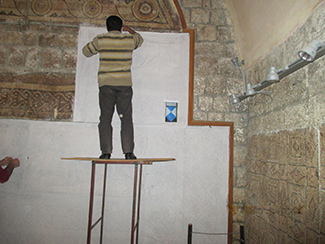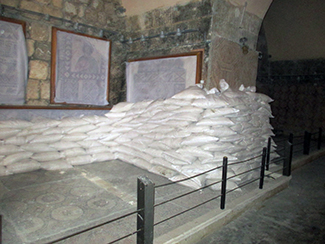Emergency Preservation Activities Completed at Syria’s Ma’arra Mosaic Museum
Penn Museum's Penn Cultural Heritage Center Part of International Consortium Seeking Ways to Take Concrete Action to Preserve Ancient Artifacts
 March 5, 2015—Syria's renowned Ma'arra Mosaic Museum, significantly damaged and in danger of collapse as a result of the country's long and ongoing civil war, has undergone emergency conservation and protection efforts by Syrian cultural heritage professionals and volunteers.
March 5, 2015—Syria's renowned Ma'arra Mosaic Museum, significantly damaged and in danger of collapse as a result of the country's long and ongoing civil war, has undergone emergency conservation and protection efforts by Syrian cultural heritage professionals and volunteers.
The emergency project, first conceived during a Syrian cultural heritage emergency workshop in the summer of 2014, was a months' long initiative of an international group of organizations: the Safeguarding the Heritage of Syria and Iraq Project (SHOSI), which is a consortium of the Penn Cultural Heritage Center at the University of Pennsylvania Museum; the Office of the Under Secretary for History, Art, and Culture at the Smithsonian Institution; the Geospatial Technologies Project at the American Association for the Advancement of Science; Shawnee State University, The Day After—a Syrian NGO; and the U.S. Institute of Peace. The consortium planned the project, coordinated necessary governmental approvals in the war-torn country, and paid for the materials required to carry out the work with support from the J. M. Kaplan Fund.
"We've seen how the invaluable cultural heritage of Syria has fallen prey to destruction by heavy artillery, targeted explosive attacks and looting as never before," noted Dr. Salam Al-Kuntar, a Syrian archaeologist, a visiting research scholar at the Institute for the Study of the Ancient World at New York University and a consulting scholar at the Penn Cultural Heritage Center. "We all know that what a group of dedicated Syrians have done is a small but meaningful act and a courageous act, taking difficult steps during wartime to preserve Syrian history for future generations. Let us hope that this will be the first of many more concrete efforts of preservation."
Housing one of the most important collections of 3rd to 6th century Roman and Byzantine mosaics in the Middle East, the Ma'arra Mosaic Museum is located about 50 miles south of Aleppo. The Museum was an old caravanseri, or roadside inn, that was constructed in 1595 and refurbished as a museum in 1987.
 The emergency protection project aimed to secure the mosaics from further harm during the conflict. After consultation with experts in mosaic conservation, the Syrian team applied a layer of glue and cloth designed to fortify and keep the tesserae together. Several truckloads of sandbags were then laid out to protect the mosaics from further damage. Altogether, some 1600 square feet of mosaics were protected. Holes in the roof were also repaired to prevent further deterioration and possible collapse.
The emergency protection project aimed to secure the mosaics from further harm during the conflict. After consultation with experts in mosaic conservation, the Syrian team applied a layer of glue and cloth designed to fortify and keep the tesserae together. Several truckloads of sandbags were then laid out to protect the mosaics from further damage. Altogether, some 1600 square feet of mosaics were protected. Holes in the roof were also repaired to prevent further deterioration and possible collapse.
"The emergency protection project of the Ma'arra Museum is a great example of the fundamental link of Syrian people to their heritage. The tremendous efforts by the Ma'arra people to protect the museum is part of their cultural struggle for surviving this atrocious war," said Shaker Al-Shbib, an expert in Syrian heritage involved with the effort.
Professor Amr Al-Azm of Shawnee State University adds, "The importance of this cultural heritage is nowhere more demonstrable than when it comes to the issue of national identity and what makes a Syrian a Syrian. Once the current violence ends, the people of Syria will need to find ways to reconnect with the symbols that once united them across religious and political lines. The country's ancient past as represented in this rich cultural heritage will be key to this process. Protecting and preserving Syria's history and heritage therefore is about safeguarding its future too."
About the Penn Cultural Heritage Center, University of Pennsylvania Museum
Dedicated to supporting cultural heritage initiatives, the Penn Cultural Heritage Center (PennCHC) brings considerable experience in training, capacity building, and basic research about cultural heritage and cultural policy. It has led several projects in conjunction with the U.S. government, including a research partnership with the U.S. Department of State's Mission to UNESCO to increase the empirical information known about the World Heritage program as it exists in the United States and abroad. PennCHC's capabilities are enhanced by the world-class archaeological and anthropological faculty at the University of Pennsylvania, and the curators of the Penn Museum. Dr. Salam Al-Kuntar, consulting scholar at the Penn Cultural Heritage Center, and Dr. Brian Daniels, Director of Research and Programs at the Penn Cultural Heritage Center, are the Center's coordinators for the Safeguarding the Heritage of Syria and Iraq Project (SHOSI).
About the Smithsonian Institution
Since its founding in 1846, the Smithsonian Institution has been committed to inspiring generations through knowledge and discovery. The Smithsonian is the world's largest museum and research complex, consisting of 19 museums and galleries, the National Zoological Park and nine research facilities. There are 6,500 Smithsonian employees and 6,300 volunteers. There were 30 million visits to the Smithsonian in 2013. The total number of objects, works of art and specimens at the Smithsonian is estimated at nearly 137 million, including more than 126 million specimens and artifacts at the National Museum of Natural History. Corine Wegener, cultural heritage preservation officer, Smithsonian Institution, is the Smithsonian's principal coordinator for the Safeguarding the Heritage of Syria and Iraq Project (SHOSI).
About The Day After (TDA)
The Day After project brought together a group of 45 Syrians representing a large spectrum of the Syrian opposition to participate in an independent transition planning process. In 2012, this group, supported by international experts in transition planning, convened six times to develop a shared vision of Syria's democratic future and to prepare a transition planning document. The TDA report, "The Day After: Supporting a Democratic Transition in Syria", provides a detailed framework of principles, goals and recommendations for addressing challenges in six key fields: rule of law; transitional justice; security sector reform; constitutional design; electoral system design; and post-conflict social and economic reconstruction. TDA has since transformed into an NGO, run by an all-Syrian Board of eight members, which aims to implement the recommendations presented in the TDA report. The Day After is an independent, Syrian-led civil society organization working to support a democratic transition in Syria. In addition to TDA's six staff members in the Istanbul office, TDA has 24 staff members working in seven provinces inside Syria. Dr.Amr Al-Azm is TDA's principal coordinator for the Safeguarding the Heritage of Syria and Iraq Project (SHOSI). For more information about TDA, please visit www.tda-sy.org
About Shawnee State University
Shawnee State is a student-focused public university offering a highly personalized, affordable, and accessible education dedicated to the exploration of emerging technologies and emerging ideas. Shawnee State was founded in 1986. Located along the Ohio River in historic Portsmouth, Ohio, the university has over 300 full and part time faculty members and 4,400 full and part-time students with a 1:18 faculty to student ratio. Dr. Amr Al-Azm, Associate professor of Middle East history and anthropology at Shawnee State University, (SSU) is SSU's principal coordinator for the Safeguarding the Heritage of Syria and Iraq Project (SHOSI). More information about Shawnee State University may be found at www.shawnee.edu.
About the U.S. Institute of Peace
The United States Institute of Peace is an independent, nonpartisan institution established and funded by Congress to increase the nation's capacity to manage international conflict without violence. Founded in 1984, its mission is to prevent, mitigate and resolve violent conflicts around the world by engaging directly in conflict zones and providing analysis, education and resources to those working for peace. More information about the U.S. Institute of Peace may be found at www.usip.org.
The Penn Museum (the University of Pennsylvania Museum of Archaeology and Anthropology) is dedicated to the study and understanding of human history and diversity. Founded in 1887, the Museum has sent more than 300 archaeological and anthropological expeditions to all the inhabited continents of the world. With an active exhibition schedule and educational programming for children and adults, the Museum offers the public an opportunity to share in the ongoing discovery of humankind's collective heritage.
The Penn Museum is located at 3260 South Street, Philadelphia, PA 19104 (on Penn's campus, across from Franklin Field). On the web: www.penn.museum. For general information: 215.898.4000.
Photos, top and bottom: Volunteers inside Syria's Ma'arra Museum complete emergency preservation activities to help protect the ancient mosaics from further attack.
###
About the Penn Museum
The Penn Museum’s mission is to be a center for inquiry and the ongoing exploration of humanity for our University of Pennsylvania, regional, national, and global communities, following ethical standards and practices.
Through conducting research, stewarding collections, creating learning opportunities, sharing stories, and creating experiences that expand access to archaeology and anthropology, the Museum builds empathy and connections across diverse cultures
The Penn Museum is open Tuesday-Sunday, 10:00 am-5:00 pm. It is open until 8:00 pm on first Wednesdays of the month. The Café is open Tuesday-Thursday, 9:00 am-3:00 pm and Friday and Saturday, 10:00 am-3:00 pm. On Sundays, the Café is open 10:30 am-2:30 pm. For information, visit penn.museum, call 215.898.4000, or follow @PennMuseum on social media.



